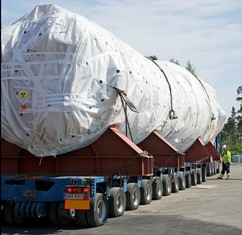Regulator OKs transatlantic SG shipment
07 February 2011
The Canadian Nuclear Safety Commission (CNSC) has granted a licence to allow the shipment of sixteen decommissioned steam generators (SGs) from the Bruce A nuclear power plant to Sweden for recycling.
 |
| Steam generator ready for transport (Image: Studsvik) |
A transport licence from the CNSC is a requisite for the transportation of the decommissioned components to Sweden. The huge components - approximately 11.7 m long, 2.5 m in diameter and weighing about 100 tonnes each - will be transported by road from their current location, in storage at the Bruce site, to the port of Owen Sound, about 120 km away. There they will be loaded onto a ship which will take them through the Great Lakes, along the St Lawrence Seaway and Welland Canal and on across the Atlantic. The ship will finally dock at the Swedish company Studsvik's Nyköping site, where the SGs will be dismantled and recycled. The voyage is expected to take about 3 weeks.
The Canadian regulator has spent several months considering information presented at a public meeting and submissions from its own staff, Bruce Power and 77 intervenors in coming to its decision to grant the transport licence. In so doing, it said, it was satisfied that the shipment met relevant national and international regulations and could be completed safely with negligible risk to the environment and the public. The licence will be valid for a period of one year from 4 February 2011 to 3 February 2012. As the shipping routes through the Great Lakes may pass through US territorial waters, the shipment will also require permission from the US authorities.
The decommissioned SGs are classed as low-level radioactive waste. Nuclear services company Studsvik's unique process for treating steam generators means that the volume of the waste can be massively reduced, but the specialised technique is only offered at its Swedish site. The decision to ship the SGs to Sweden for recycling rather than storing them as low-level waste in Canada has been the subject of debate, with many of the intervenors in the case opposing the shipment. Bruce Power even took the step of setting up a dedicated website to share information on the SG shipment and recycling plan.
The CNSC agreed with Bruce Power's assessment that reduction of the footprint of the SGs was good practice. "In this regard, the Commission believes that material that is not waste does not need to be stored as waste," it said in the formal records of its proceedings and decision.
Studsvik estimates that there will be about 400 tonnes of non-recyclable radioactive waste left at the end of the process - equivalent to around 10% of the original volume of the SGs - to be returned to Canada at a later date. Regulations already exist for the packaging and transport of such low-level waste, so no special arrangements will need to be made for the return shipment, the CNSC noted.
Bruce Power president and CEO Duncan Hawthorne welcomed the CNSC decision. "We always believed this was the right thing to do to reduce our environmental footprint and we are pleased the soundness of our case has been verified by the CNSC and a license has been approved," he said.
The four Candu reactors at Bruce A were taken out of service and laid up in the late 1990s. Facing impending shortages, the Ontario government decided to undertake major refurbishment work on units 1 and 2 to enable them to operate for a further 25 years each. Units 3 and 4 returned to service in 2004 and 2003 respectively, and are due to undergo similar refurbishment once units 1 and 2 return to service.
The major refurbishment project has included the installation of new fuel channels in the two reactors plus the new steam generators. In late January, Bruce Power announced that retubing of unit 2 had been finished and the project was 85% complete. Bruce A units 1 and 2 are expected to return to service in the second half of 2011 at the earliest.
Researched and written
by World Nuclear News